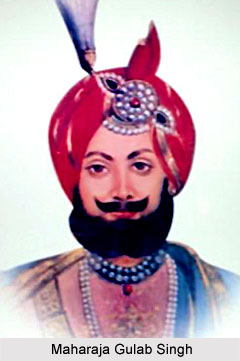 Gulab Singh was the first Maharaja of Jammu and Kashmir from the year 1846 to 1857. He was also the founder of the princely state of Jammu and Kashmir, which was the 2nd princely state during the British rule in India. When the Sikhs were defeated in the First Anglo Sikh War, Gulab Singh served as Prime Minister of the Sikhs. Later the British relocated all the lands in the region of Kashmir which were conceded to the British East India Company by the Sikhs through the Treaty of Lahore to Gulab Singh for Nanakshahi.
Gulab Singh was the first Maharaja of Jammu and Kashmir from the year 1846 to 1857. He was also the founder of the princely state of Jammu and Kashmir, which was the 2nd princely state during the British rule in India. When the Sikhs were defeated in the First Anglo Sikh War, Gulab Singh served as Prime Minister of the Sikhs. Later the British relocated all the lands in the region of Kashmir which were conceded to the British East India Company by the Sikhs through the Treaty of Lahore to Gulab Singh for Nanakshahi.
Early Life of Gulab Singh
Maharaja Gulab Singh was born on 18th October 1792, to father Kishore Singh, who was a distant relative of the ruler of Jammu Jit Singh. Gulab Singh belonged to the Jamwal clan of Suryavanshi Rajputs. He learnt the arts of warfare and horse riding from his grand father Zorawar Singh. In the year 1809, he became the commander of a Dogra cavalry contingent in the army of Ranjit Singh. In 1816, Singh led an independent campaign to triumph over the hill town of Reasi. After a conflict in 1816, Jammu was captured by Ranjit Singh and Maharaja Jit Singh was banished. He took the support of the British East India Company and received the estate of Akhrota in addition.
In the year 1821, Gulab Singh captured Kishtwar from Raja Tegh Muhammad Singh and conquered over Rajouri by defeating Aghar Khan. He also participated in the Sikh conquest of Dera Ghazi Khan. Singh also executed the rebel Mian Dido Jamwal, who belonged to his own clan.
Rule of Gulab Singh
Gulab Singh became the ruler of Jammu by his suzerain Ranjit Singh. Later, he secured an official declaration of renunciation from the overthrown Maharaja Jit Singh. The declaration transferred the headship of the Jamwal Rajputs to a junior branch of that clan. In the year 1824, Maharaja Gulab Singh conquered the Samartah fort, situated near the sacred Mansar Lake. Lter in 1827, Singh accompanied Hari Singh Nalwa, the Sikh Commander-in-Chief, who fought at the Battle of Shaidu and defeated Sayyid Ahmed who led a mass of Afghan rebels. In the following Anglo-Sikh wars, Maharaja Gulab Singh covertly allied with the British Government by providing intelligence about the Sikh Army. Under the Treaty of Lahore, the overpowered Lahore court was made to relocate Jammu to Gulab Singh. As the British lacked the resources to occupy a territory right after annexing portions of Punjab, the British East India Company identified Gulab Singh as a ruler directly branched to them on payment of a huge sum of the war indemnity.
This agreement was officially recognised in the Treaty of Amritsar in the year 1846. He provided his consent to his Sikh soldiers to fight alongside their brothers in Punjab in the second Sikh War of 1849. The treaties of Amritsar and Chushul had defined the boundaries of the state of Jammu in the east, south and west but the northern frontier was still not clearly defined. In the year 1850, the fort of Chilas in the Dard country was occupied. The region of Gilgit was occupied by rebels in 1852 but was eventually recovered after a decade by his son, Ranbir Singh.
Maharaja Gulab Singh of Jammu and Kashmir died on 30 June 1857. He was succeeded by his son Ranbir Singh.






































